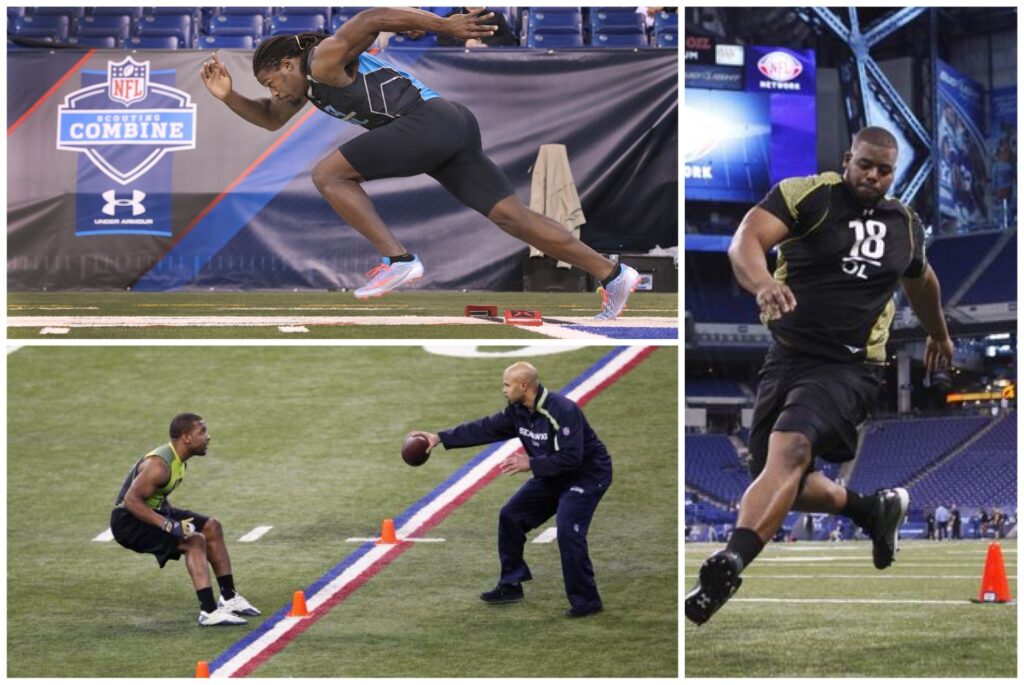Football is Played in Pads. Somehow, Football Testing Isn’t…
A series of setbacks marred Johnny Manziel’s last year in the NFL, yet it’s crucial to acknowledge the positive aspects of his performance.
In a bold move aimed at distinguishing himself from his peers in the 2014 quarterback class, Manziel conducted his pro day at Texas A&M in March donned in full gear, complete with helmet and shoulder pads.
This departure from the traditional pro day attire of shorts and t-shirts, a practice also observed at the NFL scouting combine, begs the question: Why not evaluate players in the very equipment they’ll be using in the game?
As Manziel aptly pointed out to esteemed NFL senior analyst Gil Brandt a year prior, “Isn’t the game played with them on?”
Indeed, it is.
So, why not align the evaluation process more closely with the actual conditions of play in the league?
Well, the answer seems to avoid clear justification, offering only feeble excuses.
While it’s understood that the combine primarily focuses on physical assessments rather than actual gameplay, it serves as a necessary tool to document speed and explosiveness metrics, serving as a contingency in case all game and practice footage were to vanish into thin air.
Nevertheless, the contradiction between these reference points and the attributes that scouts and coaches truly aim to evaluate remains a puzzling anomaly in an otherwise stellar sport.
The fundamental tests at the combine include:
- 40-yard dash
- Bench press (225 lbs)
- Vertical Jump
- Broad jump
- 3-Cone Drill
- Shuttle Run
We value obtaining the foundational data, which is undoubtedly essential.
However, why do we not seek this information under conditions reflective of the actual sport?
It’s logical to want to gauge an individual’s speed over a specific distance, yet conducting this assessment under circumstances they will never encounter on the field seems unreasonable.

While viewers at home might not be aware of it, including pads and a helmet can affect a football player’s capacity to execute specific movements, though to a minor extent.
Each summer, college and professional teams engage in rigorous training regimens encompassing various speed, strength, and conditioning exercises.
Any player who has undergone this process knows that individuals exhibit disparities in performance with and without pads.
This phenomenon is a recurring revelation during annual training camps—a player who appears exceptional in shorts and t-shirts, only to fade into the background once the pads are put on.
Much of this discrepancy stems from the inherent contrast between workouts and actual gameplay.
However, some can also be attributed to the distinction between moving around in a casual outfit versus donning full football gear.
Shoulder pads, in particular, introduce a degree of encumbrance. They impose limitations on achieving complete fluidity in specific movements and can pose challenges when transitioning between different body positions.
This restriction is, of course, in the interest of safety. For linear assessments, there is a discernible increase in wind resistance due to the augmented surface area—an effect akin to what players experience on the football field.
In tests requiring direction changes, such as the 3-Cone and Shuttle, the presence of pads can undeniably impact certain players.
When executing transition movements, players must contend with this slight degree of constraint—a factor inherent to the job.
The relevance of a player’s performance with full gear becomes even more pronounced during on-field positional workouts, where athletes are tasked with executing position-specific maneuvers: throwing, managing pass drops, running pass routes, or navigating through the traffic created by blocking dummies or bags.
Pads wield substantial influence across all these facets. Strangely, in a league that professes to leave no stone unturned in getting to know its players, the seemingly straightforward step of outfitting them in the attire they’ll be wearing on game day is overlooked.
It’s a curious oversight.
The only conceivable argument I can call for omitting pads during testing is the concern that new “with pads” numbers might not align precisely with the established “without pads” benchmarks.
However, in cases where speed is in question, game footage is a reliable point of reference, rendering this discrepancy inconsequential.
Any slight adjustments in recorded times, such as a shift from a 4.45 to a 4.49 in the 40-yard dash, should hardly cause consternation.
Big f***ing deal.
Some players may exhibit minimal disparity in performance with or without pads, while others assuredly will.
It baffles me why teams refrain from obtaining this straightforward piece of information.
The NFL often clings to its established routines, demonstrating a reluctance to embrace superior, common-sense solutions (a sentiment not unfamiliar in matters about Roger Goodell).
The fact that outfitting players in pads and helmets during testing aligns so seamlessly with the essence of football is perhaps the very reason it has yet to be implemented.
In this particular instance, Johnny Football found himself ahead of the NFL curve. Digesting that reality may require a moment’s pause.

